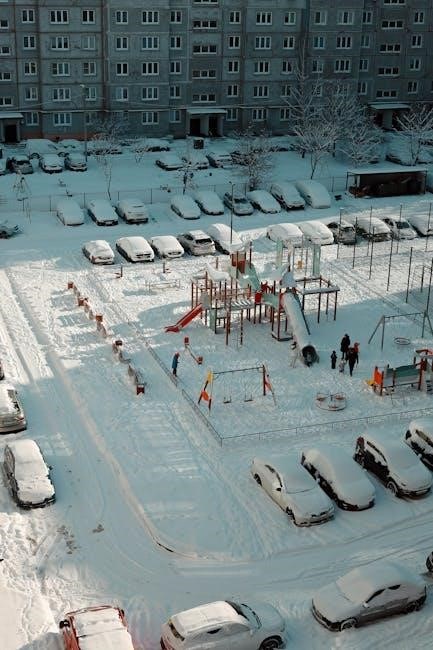Can All RV Slides Be Manually Retracted?
Not all RV slides can be manually retracted, but most modern systems offer emergency manual override options. Rack and pinion, hydraulic, and Schwintek slides often require specific tools or procedures for manual operation. Always consult your RV’s owner’s manual for precise instructions, as methods vary by manufacturer and model; Manual retraction is typically reserved for emergencies and may be labor-intensive.
1.1 Understanding Different RV Slide-Out Systems
RV slide-out systems vary in design, with three main types: rack and pinion, hydraulic, and Schwintek (in-wall). Rack and pinion systems use electric motors and gears for smooth operation, while hydraulic slides rely on fluid pressure for movement. Schwintek slides utilize vertical aluminum shafts and gear-reduction motors. Each system has unique mechanisms, making manual retraction methods distinct. Rack and pinion slides often require a manual crank or wrench, whereas hydraulic slides need valve adjustments and physical effort. Schwintek slides typically involve removing motor components to access the drive mechanism. Understanding your RV’s specific system is crucial for safe manual operation.
1.2 Limitations and Exceptions for Manual Retraction
Manual retraction of RV slides has limitations and exceptions. Hydraulic systems require opening manifold valves and physical pushing, which is labor-intensive. Schwintek slides need motor disengagement, complicating the process. Rack and pinion slides may need specific tools like a crank or wrench. Some systems, especially older models, may lack manual override features entirely. Additionally, improper manual retraction can damage gears or motors. Always follow manufacturer guidelines, as incorrect methods may void warranties or cause further issues. Manual retraction should only be used in emergencies and performed with caution to avoid system damage.

Basic Troubleshooting Steps for an RV Slide-Out That Won’t Retract
First, check the power supply and battery voltage. Ensure no obstacles are blocking the slide. Inspect for common issues like faulty motors or damaged gears. Consult the manual or a professional if problems persist to avoid further damage.
2.1 Checking Battery Voltage and Power Supply
Begin by ensuring the battery is fully charged and functioning. Use a multimeter to measure voltage at the battery terminals. A healthy system should read around 12.5-12.7 volts. If voltage is low, charge the battery or check connections for corrosion. Verify the power supply to the slide-out motor by ensuring all circuit breakers or fuses related to the system are intact. Any electrical issues should be addressed before attempting manual retraction to avoid further complications.
2.2 Identifying Common Causes of Malfunction
Common issues causing an RV slide-out to malfunction include low battery voltage, faulty control switches, or damaged wiring. Hydraulic leaks or insufficient fluid levels can also prevent proper operation. Misaligned gears or worn components within the slide mechanism may disrupt movement. Additionally, a damaged or seized motor can render the system inoperable. It’s crucial to identify the root cause before attempting manual retraction, as ignoring underlying issues may lead to further damage. Always consult the owner’s manual or a professional if unsure about the malfunction’s origin;
How to Manually Retract RV Slide-Outs
Engage the manual override crank tool on the motor, ensuring proper alignment. Turn the crank clockwise to retract the slide-out slowly and safely into place.
3.1 Rack and Pinion Slides
Rack and pinion slides use a motor-driven system for operation. To manually retract, locate the hex nut or extension rod connected to the motor. Attach the manual crank tool securely and turn clockwise to retract the slide. Ensure the area is clear and apply steady pressure to avoid damage. This method is effective for emergencies when power is lost. Always refer to your RV’s manual for specific instructions, as procedures may vary slightly between models. Proper alignment and gradual movement are key to safe manual retraction.
3.1.1 For Slide-Outs with Hex Nut Attached to the Electric Actuator Motor
For slides with a hex nut attached to the electric actuator motor, manual retraction involves using a wrench or socket to turn the nut clockwise. First, ensure the RV is stable and the area around the slide is clear. Attach the manual override tool to the hex nut and apply steady, firm pressure while turning. This process bypasses the electric motor, allowing the slide to retract slowly. Be cautious not to apply excessive force, as this could damage the mechanism. Always follow the manufacturer’s instructions for proper technique and safety.
3.1.2 For Slide-Outs with an Extension Rod from the Motor Through the I-Beam
For slide-outs with an extension rod connected through the I-beam, manual retraction requires accessing the motor’s override mechanism. Locate the extension rod and attach the manual crank tool. Turn the crank clockwise to retract the slide. Ensure the RV is on level ground and apply steady pressure to avoid jolting. If resistance is met, check for obstructions or alignment issues. This method is effective but may require physical effort. Always refer to the manufacturer’s guidelines to prevent damage to the system.
3.2 Hydraulic Slides
Manually retracting hydraulic slides requires opening the manifold valves to relieve pressure. Once the system is depressurized, physically push the slide inward. This process is labor-intensive and often needs assistance. Ensure the RV is on level ground and use blocks or wedges for stability. Hydraulic systems are designed for power operation, so manual retraction should only be done in emergencies. Avoid frequent manual operation to prevent system damage. Always consult your owner’s manual for specific instructions, as procedures may vary by manufacturer. If possible, seek professional assistance to avoid potential risks or further complications.
3.3 In-Wall (Schwintek) Slides
Manually retracting Schwintek slides involves locating the manual override, typically near the motor. Use a wrench or crank handle to turn the vertical aluminum shaft clockwise, retracting the slide. Ensure the RV is stable and on level ground to prevent movement during the process. This method is designed for emergencies and may require significant effort. Avoid frequent manual operation, as it can strain the system. Always refer to the manufacturer’s instructions for specific details, as Schwintek systems vary slightly by model. Manual retraction should only be done when power is unavailable or the motor fails.
Tools and Equipment Needed for Manual Retraction
Essential tools include a manual crank, wrench, socket, and lubrication products. These are crucial for emergency manual retraction and maintaining slide-out systems.
4.1 Essential Tools for Emergency Situations
For emergency manual retraction, essential tools include a manual crank tool, wrenches (5/8″ or 3/4″ socket), multi-meter, and lubrication products. These tools help prevent damage and ensure smooth operation. A crank handle is often required for through-frame models, while in-frame models may need a drill with a nut driver. Additionally, pliers and screwdrivers can assist with disengaging motors or removing components. Always keep these tools accessible to address unexpected issues quickly and safely. Refer to your RV’s manual for model-specific requirements.
4.2 Lubrication and Maintenance Products
Proper lubrication is crucial for maintaining smooth operation of RV slide-outs. Use silicone-based lubricating sprays or white lithium grease on moving parts like gears, hinges, and rollers. For hydraulic systems, apply waterproof grease to ensure longevity. Regularly inspect and lubricate components to prevent rust and wear. Avoid using inappropriate lubricants, as they may damage seals or attract dust. Keep a supply of these products on hand to address issues promptly and maintain optimal functionality. Always follow manufacturer recommendations for specific slide-out systems to ensure compatibility and effectiveness.

Step-by-Step Guide to Manual Retraction
Manual retraction involves locating the motor, engaging the override, and cranking slowly. Ensure stability, apply lubrication, and secure the slide firmly. Follow manufacturer guidelines precisely.
5.1 Locating the Motor and Access Point
Begin by locating the motor and access point for your RV slide-out system. The motor is typically found on the opposite side of the slide. For electric through-frame slides, look for a hole in the J-rail and another in the frame. In-wall systems may require removing interior panels to access the motor. Ensure you have the correct manual override tool, such as a crank or wrench, and verify its compatibility with your slide mechanism. Always refer to your RV’s manual for specific locations and instructions tailored to your model.
5.2 Using the Manual Override Crank Tool
To use the manual override crank tool, first ensure the slide-out is aligned properly and the RV is stable. Attach the crank to the motor’s override mechanism, typically located near the access point. For rack and pinion systems, insert the crank into the hex nut or extension rod and turn clockwise to retract. Apply gentle to moderate pressure, monitoring the slide’s movement. For hydraulic systems, refer to the manifold valve procedure. Always follow the manufacturer’s instructions and ensure the crank is securely attached to avoid slippage. Retract slowly and evenly to prevent damage.
5.3 Securing the Slide-Out After Retraction
After manually retracting the slide-out, ensure it is tightly closed and secure. Reattach any components detached during the process, such as the brake assembly or gear. Use screws or clips to fasten these parts firmly. Check the seals for proper alignment to prevent leaks or air gaps. Verify the slide-out is flush with the RV wall and evenly aligned. Engage any locking mechanisms or stabilizers to prevent movement. Finally, test the system to ensure it is fully secure and functional. Always consult your owner’s manual for specific securing instructions tailored to your RV model.

Safety Precautions and Best Practices
Ensure the RV is stable and on level ground before manual retraction. Use proper tools to avoid damage or injury. Never force the slide-out; stop if resistance is met. Always follow manufacturer guidelines and disconnect power sources if possible. Wear protective gear and keep bystanders away. Regular maintenance can prevent malfunctions and ensure smooth operation.
6.1 Ensuring Stability and Safety During Manual Retraction
Before manually retracting your RV slide-out, ensure the vehicle is on level, stable ground and apply the parking brake. Use jack stands for added support to prevent movement. Always wear protective gear, such as gloves and safety glasses, to protect yourself from potential injuries. Ensure the area around the slide-out is clear of obstacles and bystanders. Never attempt manual retraction under unsafe conditions or without proper tools. If resistance is encountered, stop immediately to avoid damage or injury. Always follow the manufacturer’s guidelines and consider seeking professional assistance if unsure.
6.2 Avoiding Common Mistakes and Potential Damage
Avoid applying excessive force, as it can damage the slide-out mechanism or surrounding structures. Never use tools that could slip or cause unintended movement. Ensure all bolts and connections are secure before retracting. Do not manually retract a slide-out if it is stuck due to obstructions without first investigating. Overlooking proper lubrication can lead to mechanical stress. Always follow the manufacturer’s manual override procedures to prevent system damage. If unsure, consult a professional to avoid costly repairs. Regular maintenance can help prevent issues requiring manual intervention.

Maintenance Tips for Preventing Future Issues
Regularly lubricate moving parts to ensure smooth operation and prevent corrosion. Inspect components for wear and tear, replacing them as needed. Keep the system clean.
7.1 Regular Lubrication of Moving Parts
Regular lubrication of moving parts is essential for maintaining smooth operation of RV slides. Use RV-specific lubrication products to prevent corrosion and wear. Apply lubricant to gears, hinges, and any metal-to-metal contact points every 3-6 months or after washing. This ensures components move freely and reduces friction, which can lead to premature wear. Additionally, inspect lubrication points during maintenance checks to ensure they are clean and properly coated. Consistent lubrication helps prevent rust and extends the lifespan of your slide-out system, ensuring reliable performance during manual retraction or automatic operation.
7.2 Inspecting and Replacing Worn Components
Regularly inspecting and replacing worn components is crucial for maintaining RV slide-out functionality. Check seals, gears, and tracks for signs of wear or damage. Lubricate moving parts and ensure all bolts and screws are tightened. Replace any worn or damaged components immediately to prevent further damage. Use manufacturer-recommended replacement parts for optimal performance. Inspect the system after each use and clean debris from moving parts. Addressing wear early prevents costly repairs and ensures smooth operation. Always follow the manufacturer’s maintenance schedule for best results. Regular inspections help identify issues before they escalate, keeping your slide-out system reliable and efficient.
